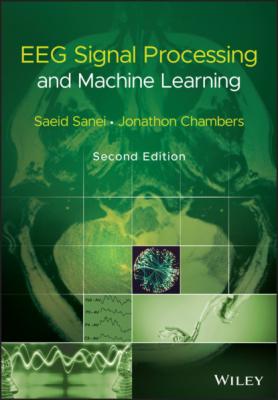EEG Signal Processing and Machine Learning. Saeid Sanei
Читать онлайн.| Название | EEG Signal Processing and Machine Learning |
|---|---|
| Автор произведения | Saeid Sanei |
| Жанр | Программы |
| Серия | |
| Издательство | Программы |
| Год выпуска | 0 |
| isbn | 9781119386933 |
3.2.1 Integrate‐and‐Fire Models
For coupling two neurons two integrate‐and‐fire neurons with mutual excitatory or inhibitory coupling have been described in [1]. The neurons with activation variables xi for i = 1, 2, satisfy:
(3.1)
where ξ >1 is a constant, 0 < xi < 1, and Ei (t) is the synaptic input to neuron i. Neuron i fires when xi = 1 and hen resets xi to 0. If cell j ≠ i fires at time tj the function Ei is augmented to Ei (t) + Es (t‐tj ), where Es is the contribution coming from one spike [1]. In an example in [1] this function is selected as:
where g and α are parameters determining the strength and speed of the synapse respectively and the factor of α 2 in (3.2) normalizes the integral of Es over time to the value g. In the considered cases the two neurons continue firing periodically when they are coupled together. Assuming that neuron 1 fires at times t = nT, where T is the period and n is an integer, while neuron 2 fires at t = (n − φ)T. Therefore, both neurons are firing at the same frequency but are separated by a phase φ. We wish to determine possible values of the phase difference φ and conditions under which they arise.
3.2.2 Phase‐Coupled Models
Neuronal synchronization processes, measured with brain imaging data, can be described using weakly coupled oscillator (WCO) models. Dynamic causal modelling (DCM) is used to fit the WCOs to brain imaging data and so make inferences about the structure of neuronal interactions [2]. The complex behaviours are mediated by the interaction of particular brain regions. Recent studies agreed that such interactions may be instantiated by the transient synchronization of oscillatory neuronal ensembles [3]. For example, contour detection is accompanied by gamma band synchronization in distant parts of visual cortex, multimodal object processing by parieto‐temporal synchronization in the beta band [4] and spatial memory processes by hippocampal–prefrontal synchronization in the theta band [2, 5]. DCM allows for different model structures to be compared using Bayesian model selection [6]. In [2] DCM has been extended to the study of phase coupling. One direction is based on the WCO models in which the rate of change of phase of one oscillator is related to the phase differences between itself and other oscillators [7].
The WCO theory applies to system dynamics close to limit cycles. By assuming that weak coupling leads to only small perturbations away from these cycles, one can reduce a high‐dimensional system of differential equations to one based solely on the phases of the oscillators, and pairwise interactions between them [2].
Dynamics on the limit cycle are given by [2]:
Figure 3.2 A pair of oscillators weakly coupled via the perturbation function p(φ 1, φ 2).
(3.3)
Then, for any perturbation of phase p(ϕ) this changes to [2]:
(3.4)
(3.5)
where:
(3.6)
For a pair of oscillators of phases φ 1 and φ 2, using the same analysis (see Figure 3.2, assuming p 12 = p 21):
(3.7)
(3.8)
If it is further assumed that the phase difference φ 2 − φ 1 = φ changes slowly, then [2]:
(3.9)
(3.10)
(3.11)
Γij (ϕ) is called phase interaction function (PIF). Similarly, for NR regions the rate of change of phase of the ith oscillator is given by:
(3.12)
where fi is the intrinsic frequency of the ith oscillator. In these formulations there are two key assumptions: the first one is that the perturbations are sufficiently small that the differentiations can equivalently be evaluated at X 0 rather than X. The second assumption is that the relative changes in the oscillator phase are sufficiently slow with respect to the oscillation frequency, that the phase offset term can be replaced by a time average.
In [2] an extension of the above WCO model is used to describe the dynamic phase changes in a network of oscillators. The use of Bayesian model comparison allows one to infer the mechanisms underlying synchronization processes in the brain. This has been applied to synthetic bimanual finger movement data from physiological models and on magnetoencephalogram (MEG) data from a study of visual working memory. The WCO approach accommodates signal nonstationarity by using differential equations which describe how the changes in phase are driven by pairwise differences in instantaneous phase.
3.2.3 Hodgkin–Huxley Model
Most probably the earliest physical model is based on the Hodgkin and Huxley's Nobel Prize winning mathematical model for a squid axon published in 1952 [8–10]. The Hodgkin and Huxley equations are important not only because they represent the most successful mathematical model in quantitatively describing the related biological phenomena but also due to the fact that deriving the model of a squid is directly applicable to many kinds of neurons and other excitable cells. According to this model, a nerve axon may be stimulated and the activated
